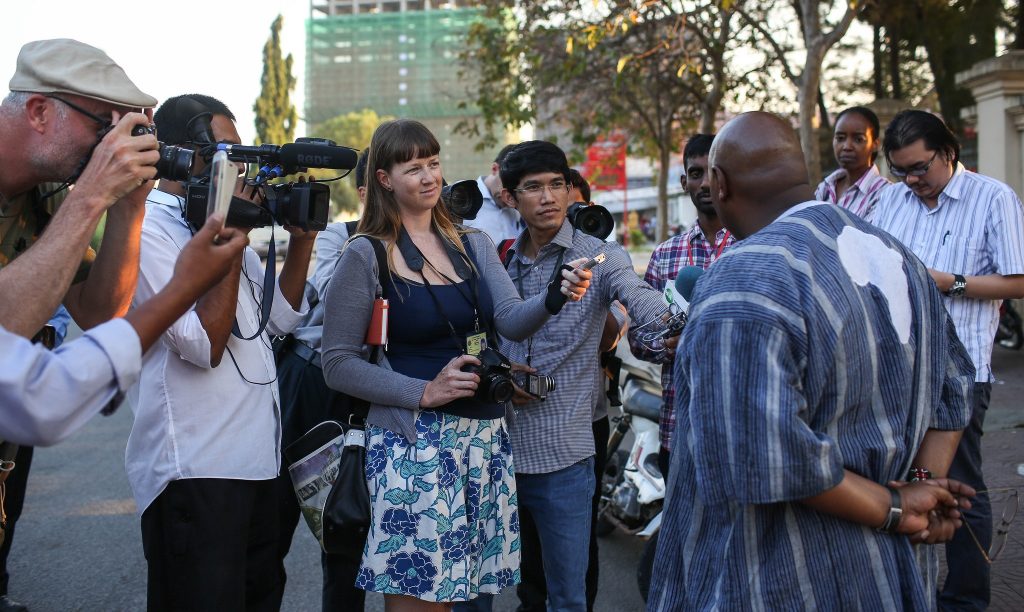
លោក Maina Kiai កំពុងនិយាយជាមួយនឹងអ្នកសារព័ត៌មានខាងក្រៅទីស្តីការក្រសួងការបរទេស ក្នុងរាជធានីភ្នំពេញ។ រូបភាព ដោយលោក Maina Kiai ថតនៅថ្ងៃទី ៦ ខែ កុម្ភៈ ឆ្នាំ ២០១៤។ ក្រោមអាជ្ញារបណ្ណ CC BY 2.0។
អង្គការមិនមែនរដ្ឋាភិបាលអន្តរជាតិសម្រាប់កិច្ចការមនុស្សធម៌ដំបូងគេ បានមកដល់ប្រទេសកម្ពុជា ក្នុងឆ្នាំ ១៩៨៩។ បន្ទាប់ពីការបោះឆ្នោតឆ្នាំ ១៩៩៣ អង្គការអន្តរជាតិកាន់តែច្រើនឡើងៗ បានចាប់ផ្តើមមកតាំងទីស្នាក់ការនៅកម្ពុជា។ មិនយូរប៉ុន្មាន បន្ទាប់ពីនោះមក អង្គការមិនមែនរដ្ឋាភិបាលក្នុងស្រុកចាប់ផ្តើមចេញរូបរាង ដើម្បីជួយគាំទ្រដល់សេចក្តីត្រូវការនានាក្នុងប្រភេទដូចគ្នា ដែលចេញពីទស្សនៈវិស័យក្នុងស្រុក។ ចាប់ពីឆ្នាំ ១៩៩២ ដែលជាការចាប់ផ្តើមដំបូងនៃការធ្វើរបាយការណ៍ផ្លូវការ រហូតដល់ឆ្នាំ ២០១៦ ទឹកប្រាក់ចំនួន ២,០៣៩,១៥៣,៤៥៧ ដុល្លារ ត្រូវបានចំណាយទៅលើគម្រោងដែលរដ្ឋាភិបាលអនុម័តជាផ្លូវការ។2 បច្ចុប្បន្ននេះ អង្គការមិនមែនរដ្ឋាភិបាលចំនួន ៦៤៧ ប៉ុណ្ណោះ ដែលកំពុងប្រតិបត្តិការសកម្ម (ទាំងបរទេស និងក្នុងស្រុក) ក្នុងចំណោម ១,៧៧៥ ឬ ១,៧៧៩ អង្គការ (តួរលេខនេះអាស្រ័យលើប្រភពព័ត៌មាននីមួយៗ) ដែលបានបំពេញកិច្ចការលើគម្រោងវិនិយោគដែលមានគុណវឌ្ឍន៍គ្រប់គ្រាន់ (QIP) ប្រមាណ ១,៦២៧ ។3
លំនាំនៃការផ្តល់មូលនិធិសម្រាប់អង្គការមិនមែនរដ្ឋាភិបាល (NGOs) និងអង្គការមិនមែនរដ្ឋាភិបាលអន្តរជាតិ (INGOs) គឺមានភាពស្រដៀងគ្នាខ្លាំង។ អង្គការមិនមែនរដ្ឋាភិបាលមួយ នឹងដាក់ពាក្យស្នើសុំជំនួយពីអង្គការមិនមែនរដ្ឋាភិបាលអន្តរជាតិ (INGOs), អង្គការពហុភាគី, ប្រជាជាតិផ្តល់ជំនួយ ឬពីអ្នកសហការឧបត្ថម្ភ។ ការស្នើសុំនេះអាចធ្វើតាមគម្រោងជាកិច្ចសន្យាគាំទ្រមូលនិធិដែលប្រទេសម្ចាស់ជំនួយស្នើឡើង ឬតាមរយៈកិច្ចគាំទ្របន្តទូទៅ។ មតិខ្លះលើកឡើងថា មូលនិធិមួយចំនួនអាចនឹងត្រូវបានកាត់បន្ថយ ឬមិនត្រូវបានធ្វើសារជាថ្មី ប្រសិនបើម្ចាស់ជំនួយមិនសប្បាយចិត្តជាមួយនឹងលទ្ធផលដែលទទួលបាន ឬជាមួយនឹងវិធីសាស្ត្រអនុវត្តន៍ក្នុងគម្រោង។ ឧទាហរណ៍ នៅដើមខែកក្កដានេះ ជំនួយប្រជាជនន័រវេស (Norwegian People’s Aid) បានផ្តាច់មូលនិធិឆ្នាំ ២០១៦ សម្រាប់សមាគមការពារសិទ្ធិមនុស្សកម្ពុជា (CHRAC) ដោយផ្អែកទៅលើការវាយតម្លៃមួយដែលពួកគេមិនបានពេញចិត្ត។ 4
និន្នាការជំនួយអភិវឌ្ឍន៍
ជាមួយនឹងការសន្មត់ពីការផ្លាស់ប្តូរគោលនយោបាយដែលរាជរដ្ឋាភិបាលបានកំណត់ទុកមុនជាស្រេចនៅក្នុងយុទ្ធសាស្ត្រចតុកោណ ដំណាក់កាលទី៣ ដូចបានរៀបរាប់ខាងលើ វិស័យអង្គការមិនមែនរដ្ឋាភិបាលទទួលបានការលើកទឹកចិត្តខ្លាំងក្នុងការបំពេញការងារកាន់តែច្រើននៅក្នុងវិស័យសាធារណៈ ក៏ដូចជាក្នុងការគ្រប់គ្រងធនធានជំនួយអភិវឌ្ឍន៍ផ្លូវការ (ODA) និងការអនុវត្តគម្រោងនានាក្នុងនាមជាដៃគូអភិវឌ្ឍន៍ និងតំណាងរាជរដ្ឋាភិបាលនៃព្រះរាជាណាចក្រកម្ពុជា។ ចាប់តាំងពីឆ្នាំ ២០១៤ ដល់ ២០១៨ វិស័យអង្គការមិនមែនរដ្ឋាភិបាលរបស់កម្ពុជា និងអង្គការមិនមែនរដ្ឋាភិបាលអន្តរជាតិ បានទទួលថវិកា ២៧៩,៨៦១,០០០ ដុល្លារអាមេរិក តាមរយៈប្រភពជំនួយពហុភាគី និងទ្វេភាគីសម្រាប់គម្រោង (QIP) ជាមួយនឹងទឹកប្រាក់ ១១០,៦៣១,០៧២.៨២ ដុល្លារអាមេរិក សម្រាប់តែឆ្នាំ ២០១៥ ប៉ុណ្ណោះ។5 ដូចដែលបានលើកឡើងនៅក្នុងទំព័រ “គោលនយោបាយអភិវឌ្ឍន៍ និងការគ្រប់គ្រង” នៅក្នុងពេលអនាគត ប្រទេសកម្ពុជានឹងស្វែងរកជំនួយឱ្យបានកាន់តែច្រើនពីតំបន់មេគង្គ និងអាស៊ីបូព៌ា។ ដំណើរការវិលជុំនេះ បានចាប់ផ្តើមលេចឡើងរួចទៅហើយ ប៉ុន្តែវិស័យអង្គការមិនមែនរដ្ឋាភិបាល នៅតែទទួលការផ្តល់មូលនិធិភាគច្រើនពីបណ្តាប្រទេស និងអង្គការពហុភាគីលោកខាងលិច។6
អង្គការមិនមែនរដ្ឋាភិបាល និងអង្គការមិនមែនរដ្ឋាភិបាលអន្តរជាតិបម្រើការងារនៅក្នុងច្រើនវិស័យ។ ខណៈដែលអង្គការមិនមែនរដ្ឋាភិបាល និងអង្គការមិនមែនរដ្ឋាភិបាលអន្តរជាតិចែកចេញគ្នាដោយម្ចាស់ជំនួយរបស់ពួកគេ ក្នុងករណីជាច្រើន តម្លៃនៃប្រទេសម្ចាស់ជំនួយអាចនឹងត្រូវបានឃើញនៅក្នុងគម្រោង ឬគោលបំណងនៃអង្គការ។ មូលនិធិសម្រាប់អង្គការមិនមែនរដ្ឋាភិបាល និងអង្គការមិនមែនរដ្ឋាភិបាលអន្តរជាតិ គឺស្ទើរតែត្រូវបានបែងចែកជាពីរស្មើគ្នាយ៉ាងឥតខ្ចោះដោយតំបន់របស់ម្ចាស់ជំនួយ។ វិស័យ “ដឹកជញ្ជូន”, “កសិកម្ម”, “សេវាកម្មពាណិជ្ជកម្ម និងហិរញ្ញវត្ថុ”, “អភិវឌ្ឍន៍ជនបទ,” “ថាមពល,” “អគ្គិសនី,” និង “បច្ចេកវិទ្យា ព័ត៌មាន និងទូរគមនាគមន៍”(ដែលផ្តាច់មុខដោយជំនួយរបស់ជប៉ុន) សម្រាប់អង្គការមិនមែនរដ្ឋាភិបាលនានា គឺត្រូវបានផ្តល់មូលនិធិទាំងស្រុង ឬយ៉ាងលើសលុបដោយម្ចាស់ជំនួយអាស៊ី។ អង្គការមិនមែនរដ្ឋាភិបាលដែលនៅក្នុងវិស័យ “យេនឌ័រ”, “សហគមន៍ និងសុខុមាលភាពសង្គម,” និង “ទេសចរណ៍” ត្រូវបានផ្តល់មូលនិធិដោយបណ្តាប្រទេសលោកខាងលិចតែប៉ុណ្ណោះ។ វិស័យ “សុខភាព” និង “ការអប់រំ” ត្រូវបានគេបែងចែកដោយស្មើភាពគ្នាទៅតាមតំបន់។7
ឱកាស និងការប្រឈម
អង្គការមិនមែនរដ្ឋាភិបាលទទួលជំនួយពីបណ្តា ប្រទេសលោកខាងលិចទាំងនេះ កំពុងស្ថិតក្រោមការពិនិត្យយ៉ាងហ្មត់ចត់ដោយបទប្បញ្ញត្តិរបស់រដ្ឋាភិបាល។ ការអនុម័តច្បាប់ស្តីពីសមាគម និងអង្គការមិនមែនរដ្ឋាភិបាល (LANGO)8 បានលើកឡើងជាការព្រួយបារម្ភពីសំណាកសហគមន៍អន្តរជាតិ។ ក្នុងចំនោមការព្រួយបារម្ភទាំងនោះ រួមមាន ការតម្រូវឲ្យចុះបញ្ជីជាចាំបាច់សម្រាប់រាល់សមាគមក្នុងស្រុក និងអន្តរជាតិ ការប្រុងប្រយ័ត្នដោយស្វយ័តដោយក្រសួងមហាផ្ទៃលើការចុះបញ្ជី លក្ខខណ្ឌអំពី “អព្យាក្រឹតភាពខាងនយោបាយ” និងអាណត្តិដែលអង្គការមិនមែនរដ្ឋាភិបាលក្នុងស្រុក និងអន្តរជាតិចាំបាច់ត្រូវរាយការណ៍រាល់លំហូរហិរញ្ញប្បទានចូល និងចេញ។9 ក្រុមអ្នករិះគន់ច្បាប់នេះ និយាយថា លក្ខខណ្ឌតម្រូវឲ្យអង្កការមិនមែនរដ្ឋាភិបាល និងសមាគមទាំងអស់ ត្រូវទៅចុះបញ្ជីជាមួយរដ្ឋាភិបាល តាមការពិត គឺសម្រាប់រដ្ឋាភិបាលតាមដានសកម្មភាពអង្គការ។10 ការអះអាងបែបនេះ ធ្វើឲ្យកាន់តែសង្ស័យឡើងដោយសារតែកង្វះតម្លាភាពក្នុងការយល់ព្រមលើការចុះបញ្ជី ដែលជាកត្តាធ្វើឲ្យរដ្ឋាភិបាលត្រូវមានឆន្ទានុសិទ្ធិពេញលេញ ក្នុងការបដិសេធមិនព្រមចុះបញ្ជី។ ការចុះបញ្ជីអាចនឹងត្រូវបានបដិសេធចំពោះ “អង្គការទាំងឡាយណា ដែលគោលបំណង និងគោលដៅរបស់អង្គការនោះត្រូវបានរកឃើញថា នឹងគ្រោះថ្នាក់ដល់សន្តិសុខ ស្ថេរភាព និងសណ្តាប់ធ្នាប់សាធារណៈ ឬប៉ះពាល់ដល់សន្តិសុខជាតិ ឯកភាពជាតិ វប្បធម៌ ប្រពៃណី និងទំនៀមទម្លាប់នៃសង្គមជាតិកម្ពុជា”។11 ប្រសិនបើត្រូវបានរកឃើញថាមិនអនុលោមតាមច្បាប់ទេ អង្គការទាំងនេះអាចប្រឈមនឹងហានិភ័យនៃការមិនអនុញ្ញាតឱ្យចុះបញ្ជី ឬត្រូវបានបិទទ្វារតែម្តង។12
យោងតាមរាជរដ្ឋាភិបាលនៃប្រទេសកម្ពុជា ច្បាប់ស្តីពីសមាគម និងអង្គការមិនមែនរដ្ឋាភិបាល (LANGO) ដែលត្រូវបានសម្រេចថាស្របនឹង “រដ្ឋធម្មនុញ្ញ” កាលពីខែ សីហា ឆ្នាំ ២០១៥ កន្លងមកនេះ ដោយ ក្រុមប្រឹក្សាធម្មនុញ្ញនៃប្រទេសកម្ពុជា ត្រូវបានបង្កើត “ដើម្បីការពារសិទ្ធិសេរីភាពក្នុងការបង្កើតសមាគម និងអង្គការមិនមែនរដ្ឋាភិបាល នៅក្នុងព្រះរាជាណាចក្រកម្ពុជា សម្រាប់ ការពារផលប្រយោជន៍ស្របច្បាប់របស់ពួកគេ និងផលប្រយោជន៍សាធារណៈ ក៏ដូចជាសម្រាប់លើកកម្ពស់ភាពជាដៃគូ និងកិច្ចសហប្រតិបត្តិការរវាងសមាគម និងអង្គការមិនមែនរដ្ឋាភិបាល និងអាជ្ញាធរសាធារណៈ”។13 បន្ថែមពីនេះ សេចក្តីសម្រេចនេះ ត្រូវបានធ្វើឡើងស្របគ្នាជាមួយនឹងយុទ្ធសាស្ត្រនៃបទប្បញ្ញត្តិដទៃទៀត សំដៅគាំទ្រយុទ្ធសាស្ត្រចតុកោណ ដំណាក់កាលទី៣ ដែលអំពាវនាវរកការគ្រប់គ្រងមជ្ឈការ និងការធ្វើសមាហរណកម្មរដ្ឋាភិបាល ជាមួយនឹងវិស័យអង្គការមិនមែនរដ្ឋាភិបាល នៅក្នុងកិច្ចការសាធារណៈ។ យុទ្ធសាស្ត្រអភិវឌ្ឍន៍របស់ប្រទេសនេះដាក់ចេញរបៀបវារៈនេះយ៉ាងច្បាស់ និងធ្វើឲ្យបន្ស៊ីគ្នាជាមួយគោលដៅអភិវឌ្ឍន៍ដោយចីរភាពរបស់អង្គការសហប្រជាជាតិ ក៏ដូចជាការលើកកម្ពស់ដល់សេដ្ឋកិច្ចរបស់ប្រទេសនេះផងដែរ។
ធ្វើបច្ចុប្បន្នភាពចុងក្រោយ៖ ថ្ងៃទី ១៤ ខែ កក្កដា ឆ្នាំ ២០១៦
ទាក់ទងនឹងជំនួយអភិវឌ្ឍន៍ឯកជន និងមិនរកប្រាក់កម្រៃ
- ជំនួយអភិវឌ្ឍន៍ពហុភាគី
- ជំនួយអភិវឌ្ឍន៍ទ្វេភាគី
- គោលនយោបាយអភិវឌ្ឍន៍ និងការគ្រប់គ្រង
- ទំនាក់ទំនងអន្តរជាតិ
ឯកសារយោង
- 1. ក្រុមប្រឹក្សាអភិវឌ្ឍន៍កម្ពុជា (CDC). ទិន្នន័យអំពីអង្គការមិនមែនរដ្ឋាភិបាលនៅកម្ពុជា។ http://cdc.khmer.biz/ngo/
- 2. ក្រុមប្រឹក្សាអភិវឌ្ឍន៍កម្ពុជា (CDC). ទិន្នន័យអំពីអង្គការមិនមែនរដ្ឋាភិបាលនៅកម្ពុជា។ http://cdc.khmer.biz/ngo/
- 3. ក្រុមប្រឹក្សាអភិវឌ្ឍន៍កម្ពុជា (CDC). ទិន្នន័យអំពីអង្គការមិនមែនរដ្ឋាភិបាលនីកម្ពុជា. “សេចក្តីសង្ខេប៖ ព័ត៌មានសង្ខេបអំពីអង្គការមិនមែនរដ្ឋាភិបាល និងគម្រោង.” ចូលអាននៅថ្ងៃទី ១៤ ខែ មិថុនា ឆ្នាំ ២០១៦។ http://cdc.khmer.biz/ngo/summary/summary.asp
- 4. Jack Davies. “ម្ចាស់ជំនួយសំខាន់របស់ CHRAC ផ្អាកការផ្តល់មូលនិធិ.” កាសែតភ្នំពេញប៉ុស្តិ៍, ចុះថ្ងៃទី ៨ ខែ កក្កដា ឆ្នាំ ២០១៦។ ចូលអានថ្ងៃទី ១៤ ខែ កក្កដា ឆ្នាំ ២០១៦។ http://www.phnompenhpost.com/national/key-chrac-donor-suspends-funding
- 5. ក្រុមប្រឹក្សាអភិវឌ្ឍន៍កម្ពុជា (CDC). ទិន្នន័យអំពីអង្គការមិនមែនរដ្ឋាភិបាលនៅកម្ពុជា. “ប្រភពមូលនិធិនៃអង្គការមិនមែនរដ្ឋាភិបាល ឆ្នាំ ២០១៤-២០១៨.” http://cdc.khmer.biz/ngo/report/listing_by_lastupdate.asp
- 6. ក្រុមប្រឹក្សាអភិវឌ្ឍន៍កម្ពុជា (CDC). ទិន្នន័យអំពីអង្គការមិនមែនរដ្ឋាភិបាលនៅកម្ពុជា. បញ្ជីនៃគម្រោងនានារបស់អង្គការមិនមែនរដ្ឋាភិបាលរៀបតាមលំដាប់ម្ចាស់ជំនួយ (២០១៥)។ http://cdc.khmer.biz/ngo/report/project_listing_by_source_of_fund.asp
- 7. ក្រុមបឹក្សាអភិវឌ្ឍន៏កម្ពុជា (CDC). ទិន្នន័យអំពីអង្គការមិនមែនរដ្ឋាភិបាលនៅកម្ពុជា. “ខ្ទង់ចំនាយតាមវិស័យ, ម្ចាស់ជំនួយ និងឆ្នាំ.” ចូលអានថ្ងៃទី ១២ ខែ កក្កដា ឆ្នាំ ២០១៦។
- 8. គណៈកម្មាធិការសហប្រតិបត្តិការដើម្បីកម្ពុជា (CCC). ច្បាប់ស្តីពី សមាគម និងអង្គការមិនមែនរដ្ឋាភិបាល(LANGO)។ http://ccc-cambodia.org/downloads/ngolaw/draftlaw/Unofficial%20Translation%20LANGO.pdf
- 9. ពង់ ឈីវកេក. អង្គការ LICADHO (2009). Tom Lantos គណៈកម្មាធិការសិទ្ធិមនុស្សនៅកម្ពុជា។ https://www.licadho-cambodia.org/reports/files/136LICADHOTestimonyTLHRCUSCongress09.pdf
- 10. មជ្ឈមណ្ឌលអន្តរជាតិសម្រាប់ច្បាប់មិនរកប្រាក់ចំនេញ (ICNL). “អង្គការមិនមែនរដ្ឋាភិបាលចាត់ចែងច្បាប់: កម្ពុជា.” មិថុនា ២០១៦។ ចូលអានថ្ងៃទី ១២ ខែ កក្កដា ឆ្នាំ ២០១៦។ http://www.icnl.org/research/monitor/cambodia.html
- 11. គណៈកម្មាធិការសហប្រតិបត្តិការដើម្បីកម្ពុជា (CCC). ច្បាប់ស្តីពី សមាគម និងអង្គការមិនមែនរដ្ឋាភិបាល(LANGO). ជំពូក ២, មាត្រា ៨។ ចូលអាននៅថ្ងៃទី ២៨ ខែ មិថុនា ឆ្នាំ ២០១៦។ http://ccc-cambodia.org/downloads/ngolaw/draftlaw/Unofficial%20Translation%20LANGO.pdf
- 12. ពង់ ឈីវកេក. អង្គការ LICADHO (2009). Tom Lantos គណៈកម្មាធិការសិទ្ធិមនុស្សនៅកម្ពុជា។ https://www.licadho-cambodia.org/reports/files/136LICADHOTestimonyTLHRCUSCongress09.pdf
- 13. គណៈកម្មាធិការសហប្រតិបត្តិការដើម្បីកម្ពុជា (CCC). ច្បាប់ស្តីពី សមាគម និងអង្គការមិនមែនរដ្ឋាភិបាល(LANGO). ជំពូក ១, មាត្រា ១។ ចូលអាននៅថ្ងៃទី ២៨ ខែ មិថុនា ឆ្នាំ ២០១៦។ http://ccc-cambodia.org/downloads/ngolaw/draftlaw/Unofficial%20Translation%20LANGO.pdf

